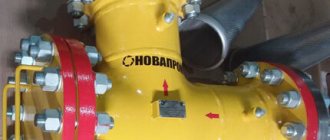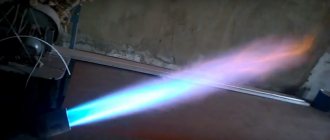Last Updated on 10/09/2017 by Sia
The installation of a heated floor does not tolerate errors or inaccuracies. If you do not follow the technology, the system will periodically not work or it is guaranteed to break down. Damper tape for heated floors is a mandatory element that allows the screed to maintain its functions, because it allows it to expand without destroying the layer.
Many experts advise analyzing current trends in the installation of heated floors. Manufacturers annually release new products that simplify the process of system assembly, calculation and operation.
What is a damper tape and why is it needed?
Damper, edge or damping tape is polyethylene foam cut into strips. It is used in the construction of concrete floors. Serves to compensate for thermal expansion and ensures that the floating slab does not come into contact with the walls.
How does a damper tape for floor screed work? Air bubbles in the polymer film are compressed and restore their shape after the load is removed. This is important since the loads on the material are periodic. In the design of a floor screed, the damper tape performs several functions at once:
Why do you need a damper tape: to decouple a floating screed from the wall, to improve sound insulation
- If the screed is floating, it is not connected to the base. Also, it should not come into contact with the walls, otherwise, with inevitable movements, either the screed or the wall will break.
- Damper tape is also used in screeds on a concrete base (not floating). Here it serves to improve sound insulation. This way the screed is isolated from the supporting structures, and this reduces the transmission of impact noise.
- Its presence reduces the number of cracks that form when the screed matures. The concrete does not come into contact with the walls, so reducing the size does not “tear” the slab as much. But to reduce cracks and their number it is necessary to use reinforcement, and the damping layer around the perimeter is only an auxiliary factor.
- In the design of a warm water floor, the tape around the perimeter ensures the presence of a gap that compensates for expansion when heated. Otherwise, the increasing size of the slab will put pressure on the walls and this will not end well.
With self-adhesive strip
When heating the floor, along the outer walls along with the damper tape (or instead), it is better to install strips of thermal insulation material. This will allow you not to heat the external walls and reduce the cost of maintaining heat. This has been verified.
There is another function that this material performs. It serves for thermal insulation. Contact between the wall and the floor is eliminated, which reduces heat loss. But this is rather a consequence rather than a purpose. So, if the screed is floating (on insulation, waterproofing) or the floor is heated, a damper tape for the floor screed is definitely needed. Other cases are up to you to choose from. In principle, its presence is also mandatory in high-rise buildings. If you simply fill the screed, sound insulation standards will not be met. What does this mean for you? Trouble with neighbors.
When you can get by
Where and when can damper tape not be used? There are several cases.
- A regular screed is poured onto a rigid, stable base.
- If there is thermal insulation around the perimeter of the room for floor insulation and its height is not lower than the level of the screed.
Edge tape for self-leveling flooring is not needed if the layer is less than 1 cm and there is no heating - When pouring a thin-layer leveling screed from quick-hardening mixtures or a self-leveling floor without heating up to 1 cm thick, an edge tape is not needed;
- for thicknesses greater than 1 cm, edge tape is required.
If we pour leveling mixtures onto a heated floor, a thermal gap is required in any case. So the edge tape is needed in the doorway too.
Advantages
The advantages of this product compared to other materials are related to the technical and operational characteristics of foamed polyethylene:
- excellent sound and heat insulation qualities, vibration absorption;
- high levels of moisture resistance and moisture resistance - characteristics that are of particular importance for floors;
- absence of linear deformation due to changes in temperature and moisture;
- plasticity: foamed polyethylene is able to compress and recover without tearing, so concrete can expand without negative consequences;
- complete tightness and strength;
- no rotting, biological stability;
- durability;
- easy installation.
In addition, this material is distinguished by a high degree of environmental friendliness, so it is absolutely safe for use in residential areas.
Materials, types, types
The polyethylene from which the damper tape is made can be uncrosslinked or crosslinked. Unstitched is cheaper, but less elastic, the walls can burst under significant load. Sewn is many times more expensive, but also more reliable. This explains the significant price difference that can be found for material of the same length/width/thickness. The type of material is indicated in the specifications. Also, the price depends on the density. This characteristic is not always indicated, but an indirect sign of higher density is greater mass. You just need to take into account the size of the tape.
T-shaped damper tape for organizing expansion and intercontour seams
There are two types of damper tape for screeds: edge and intercircuit T-shaped. The edge one is the one that rolls along the wall. Intercontour is used when constructing expansion joints in screeds - with a large floor area (more than 6 meters in length). It is more convenient to install it in a doorway; this material is used to separate the screed in the area of action of different heating circuits for water heated floors.
Types of edge (edge) damper tape
There are three types of tape:
- Standard. It's just a strip of polyethylene foam.
- With self-adhesive base. An adhesive composition is applied to one side, protected with wax paper. During installation, the paper is removed and the material is pressed against the wall. Due to the adhesive composition, it is fixed.
- With a skirt. Damper tape with a polyethylene outlet on one side. The width of the outlet is from three to ten centimeters. During installation, the skirt is laid out on the floor. This material also reduces the likelihood of leaks at the junction of the wall and floor, which is important.
The waterproofing is placed on the walls and secured, then the damper tape is unrolled and attached.
If waterproofing is spread on the floor, it is usually placed on the walls and secured there. The damper tape is laid in front of the waterproofing (as viewed from the center of the room). It turns out to be a double layer of material to some height, but this is not a problem.
Manufacturers
Mounting tape for underfloor heating is produced by different companies. Manufacturers offer customers materials that vary in parameters: density, additional equipment, etc.
p, blockquote 21,0,0,0,0 —>
Let's look at popular manufacturers of this tape.
p, blockquote 22,0,0,0,0 —>
| Manufacturer | Characteristic |
| Oventrop | The company specializes in the production of fittings for heating systems, water supply systems, and gas supply. The mounting tape for underfloor heating is made by the manufacturer Oventrop from polyethylene foam and has a perforated self-adhesive film for precise adjustment at right angles to the internal and external corners of the room, as well as for better fastening to walls with different types of primers. At the moment, in the assortment you can find: - Oventrop side insulating tape 150x10 mm (25 m roll) at a price of 1,800 rubles, - side insulating tape 120x10 mm (50 m roll) - costing 4,000 rubles, - dividing profile 120 x10 mm, length 1.20 m, made of foamed polyethylene, for making expansion joints (pieces/1.2 m) – price 1,025 rubles. |
| Uponor | Uponor has been on the market for over 60 years, developing and producing plastic pipes, components and systems. The manufacturer has been providing its products in Russia since 1995. Today Uponor offers its latest technologies for creating a favorable microclimate in a country house or cottage. Damping tape for underfloor heating made of porous polyethylene in accordance with DIN 18560, with a self-adhesive back side and an apron made of polyethylene film for hermetically sealed fastening to the wall and waterproofing. Used together with Uponor Minitec panels to lay Uponor Minitec Comfort Pipe 9.9 mm (roll length 20 m). |
| Kermi | Kermi boasts fifty years of experience and innovative solutions. High quality is fundamental at all stages of product creation. The quality of the products created is confirmed by CE and RAL marks and complies with DIN EN standards. In a system that ensures quality, compromises are not allowed. Kermi products are certified (ISO 9001:2008, 14001:2004). |
p, blockquote 23,0,0,0,1 —>
The damper tape for underfloor heating is “responsible” for the durability of the screed and is very important when installing a concrete coating. The material serves as a shock absorber and provides excellent sound insulation, makes heat loss insignificant and thereby saves the owner money.
Dimensions of damper tapes
The most common edge damper tape is 8 mm and 10 mm thick, but can be 2-3-5 mm. In small rooms it is usually recommended to use 8 mm; in larger rooms it is better to use 10 mm thick.
Many have excess tear lines. They should be on top. This will make it easier to remove excess height
The width of the damper edge tape ranges from 6-8 cm to 20 cm, but most often 10-15 cm are available for sale. As a rule, this width is excessive. When installing it, it is fixed to its full height, after which the excess is cut off to a level with the final finishing of the floor. Some manufacturers make several tear-off lines for convenience. Sold in rolls of various lengths: minimum length is 10 meters, maximum 100 or 150 meters.
How to install and secure
The edge damper tape is laid out along the perimeter of the walls. If the tape has an adhesive strip, there are no discrepancies. We unfold it so that the glue faces the wall. If there is no adhesive strip, the shiny side should be turned towards the wall, release the film (if any), lay it out on the floor. We do not stretch the tape, we lay it loosely. Those with skirts can generally wrinkle a little, otherwise the skirt will be stretched. In the corner on the floor, fold the release of the plastic film into a triangle. There's no point in trying too hard to post it. Just to avoid coattails.
When laying, the damper tape is not stretched. The skirt is straightened on the floor
In general, everything is simple. The manufacturers themselves roll the material so that it is convenient to install. Material for right-handed people has been rolled up. That is, we place the roll on the floor, secure the edge and then roll it out from left to right. If two pieces are connected, an overlap of about 5 cm is needed.
You can attach the damper tape to the wall using staples, glue, tape or... Not at all
The quickest and easiest way to attach the damper tape to the walls is with staples from a construction stapler. You can use liquid nails, double-sided tape. The question is not fundamental. You don’t have to fasten it at all, but then when laying concrete and during further work, you will need to make sure that the damper tape does not fall.
At what height should the fasteners be installed? The best option is in the middle of the width of the tape. In any case, not higher than the planned finished floor line. In most cases it is cut off, so it will be easier if the fasteners are installed lower. It is not necessary to trim off the excess, but it seems more “aesthetically pleasing.”
Purchasing a heated floor system kit
First of all, you need to buy a heated floor kit, which includes:
- curved heating cable (width - 45 centimeters) in a mesh film;
- thermal regulator for controlling the temperature of the floors - installed somewhere on the wall of the room;
- connecting wires.
Depending on the manufacturer, the kit may also include corrugated pipes and double-sided tape. The approximate price of the kit can be around one and a half thousand rubles per square meter. Therefore, when creating heated floors in small rooms (for example, in a bathroom or toilet), the cost of creating the system will not be too high. In addition, the rule applies - the larger the area of the system, the lower the cost of its creation per square meter. The minimum size of the kit is 1 square meter.
Additionally, it is advisable to purchase foiled polyethylene foam (penofol). This material reduces heat loss and optimizes electrical energy costs in the future.
Foil polyethylene foam (penofol)
In addition to the heated floor system, you need to buy everything you need to lay the tiles. In addition to the tiles you will need:
- tile adhesive;
- notched spatula for treating tiles with glue;
- grout;
- plastic crosses and wedges for seams.
At what height to trim
In general, the damper tape is needed for the screed, so you can safely cut it to the edge with the concrete slab. But the finishing materials laid on it also have thermal expansion. They are mounted with this in mind - leaving an empty space between the edge and the wall. This gap is usually 1 cm in size. So if you have a 10 mm thick edge installed, it does not need to be trimmed. In this case, the required technological gap will be maintained automatically.
The buffer tape for floor screed must be continuous
So, the damper tape can be cut flush with the concrete slab, or at the level of the finished floor, or not cut. What is not allowed is for it to be below the concrete level.
What can be replaced
In general, damper tape is not the cheapest material. It is quite possible to find materials with the same properties, but cheaper. Without a skirt and an adhesive layer, but this is advanced functionality. If your budget is limited, you can replace the edge damper tape:
- polyethylene backing for the laminate, cut into strips of the required width;
- rubber band;
- old linoleum;
- penofol cut into strips.
If you are pouring screed over joists, you also need damper tape.
There is another cheap option. Instead of damper tape, use thin wooden strips wrapped in plastic film. After the concrete has set, they are removed. A void can be left, or it can be filled.
How to fill the seam
In general, damper tape is a consumable material. That is, it is not removed from the screed and is not reused. But if you don't like the idea, you can delete it. And so that the gap does not fill with debris and insects do not live in it, it is filled with silicone sealant, which remains elastic after drying. But this option cannot be called cheap. The high consumption of expensive silicone makes savings irrelevant.
Buffer/damper/edge/edge floor tape for screed: how to install it
You can fill the gap with foam. Cut off the excess after hardening, but not to the level with the coating or screed, but a little deeper. Apply the same silicone on top. And the elasticity will remain, and there will be no gaps, and debris/insects will not annoy.
How and with what to cut
Most substitutes for damper tape are rolled materials. They can be cut into strips of the required width. If you need to be more or less careful, take a board, a sharp knife and a long ruler. Roll out the substrate, Izolon or other selected material. We lay a board under it along the edge. Place a ruler at the required distance from the edge and cut.
Ready for further work
To speed up the process, we fold the material in several layers, and then everything is the same. We put the board down, apply a ruler and cut along it. But we try to cut through all the layers at once down to the wood. It doesn't work out very nicely, but it's much faster.
Another way is to hang it with scissors. But this is not ideal at all, so you can do what is necessary. It’s also long and tedious, especially if you have to cut it for the whole apartment or house. The total is more than a hundred meters. So be patient. You can speed it up by sawing with a saw. If you are not a perfectionist, this is a great way.











